A celebration of 16 World and 49 U.S. Chess Hall of Fame Inductees. View historical artifacts including books, photographs, chess sets, and more.
On View: September 9, 2011 - February 12, 2012
The World Chess Hall of Fame was created in 1986 by the United States Chess Federation and its president at the time, E. Stephen Doyle. Originally known as the U.S. Chess Hall of Fame, the museum opened in 1988 in the basement of the Federation's then headquarters in New Windsor, New York, with an exhibition featuring a book of chess openings signed by Bobby Fischer, the Paul Morphy silver set, and cardboard plaques honoring past grandmasters. In 1992, the U.S. Chess Trust purchased the museum and moved its contents to Washington D.C. From 1992 to 2001, the collection grew to include the World Chess Championship trophy won by the U.S. team in 1993, numerous chess sets and boards, and the U.S. and World Hall of Fame inductee plaques.
In 2001, the institution moved into a new, multi-million dollar facility at the Excalibur Electronics headquarters in Miami, Florida and was renamed the World Chess Hall of Fame and Sidney Samole Museum. As General Manager of Fidelity Electronics, Samole conceived of the first chess computer, Chess Challenger 1, in 1977, and the new museum’s name was a tribute to his pioneering work at the intersection of chess and modern technology. Under the leadership of Executive Director Al Lawrence, the museum continued collecting chess sets, books, tournament memorabilia, advertisements, photographs, furniture, medals, trophies, and journals until it closed in 2009.
Due to the vibrancy of Saint Louis and the growing international reputation of the Chess Club and Scholastic Center of Saint Louis, it was then proposed that the contents of the Miami institution be moved to Saint Louis. Realizing the potential to provide area youth with a vital educational resource, Jeanne and Rex Sinquefield provided seed funding to relocate the institution to Saint Louis. U.S. Chess Trust President Jim Eade, Mr. Sinquefield, and other staff and board members from both the Trust and the USCF approved the move in August 2010.
The World Chess Hall of Fame opened on September 9, 2011 in Saint Louis in the Central West End, a bustling neighborhood in the heart of the city. Housed in a 15,900 square-foot residence-turned-business, the World Chess Hall of Fame is located directly across the street from the Chess Club and Scholastic Center of Saint Louis and features the U.S. and World Chess Halls of Fame, displays of artifacts from the permanent collection, and temporary exhibitions highlighting the great players, historic games, and rich cultural history of chess. The WCHOF partners with the Chess Club and Scholastic Center to provide innovative programming and outreach to local, national, and international audiences.
The World Chess Hall of Fame presented highlights from the permanent collection, which included chess sets donated by important players and collectors, a selection of important books like Chess Made Easy, letters written by Bobby Fischer and José Raúl Capablanca, and the Fidelity Chess Challenger, the first chess computer, which was invented by Sidney Samole and Ron C. Nelson. In addition, to celebrate the rich history of chess in Saint Louis, a small exhibition highlighted important chess events in the city’s history. Curated by Bradley Bailey.
To learn more about the inductees to the U.S. Chess Hall of Fame click here.
To learn more about the inductees to the World Chess Hall of Fame click here.
Artifacts Featured in the Exhibition

Tiffany Chess Set, 1970s
Collection of the World Chess Hall of Fame
This is one of many sets donated to the collection of the Hall of Fame by Floyd Sarisohn, a lawyer and collector of chess sets from Long Island, New York and his wife, Bernice. This solid pewter and sterling silver set, designed by Emil Pott, was made in Austria for Tiffany & Co. in the 1970s. Together with the board, which is inlaid with black and white leather, this is a classic example of the use of abstraction in modern chess-set design.

Donald Byrne Chess Set, date unknown
Collection of the World Chess Hall of Fame

Donald Byrne Chess Set (Lid), date unknown
Collection of the World Chess Hall of Fame
This set, possibly of Mexican or Filipino origin, belonged to International Master and U.S. Hall of Fame member Donald Byrne, perhaps best known for being the opponent of a thirteen-year-old Bobby Fischer in the Game of the Century in 1956. According to his brother, Grandmaster and fellow Hall of Fame member Robert Byrne, this was Donald’s favorite set. The images on the case, composed of mixed wood veneers using a technique called marquetry, are of unknown locales. This set was donated to the Hall of Fame by Robert Byrne.

Chancellor Chess: Or The New Game of Chess, Ben R. Foster, A.M., 1889
Autographed First Edition
Collection of the St. Louis Mercantile Library at the University of Missouri-St. Louis
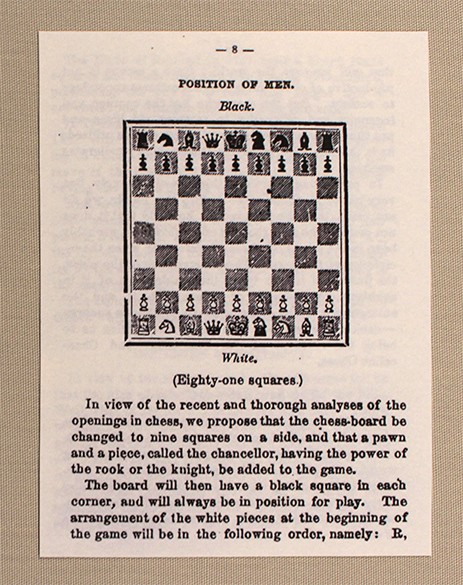

Postcard written by Ben Foster (Front), dated August 28, 1893
Collection of the John G. White Chess and Checkers Collection, Cleveland Public Library

Postcard written by Ben Foster, dated August 28, 1893
Collection of the John G. White Chess and Checkers Collection, Cleveland Public Library
Benjamin Foster, a native Saint Louisian and author of the chess column in the St. Louis Globe Democrat, published Chancellor Chess: Or the New Game of Chess in 1889. In his book, Foster introduced a chess piece called the "chancellor," a piece with the combined power of the rook and knight, as well as an additional pawn to an enlarged 81-square board. Despite a concerted effort to promote Chancellor Chess, Foster’s proposal was rebuffed by his peers. Foster served as secretary and treasurer for the St. Louis Chess Club from 1884-1904.

Consultation telegraph chess games played by chess clubs in Quincy, Illinois and Saint Louis, Missouri, Game 1, December 28, 1859
Collection of the John G. White Chess and Checkers Collection, Cleveland Public Library

Consultation telegraph chess games played by chess clubs in Quincy, Illinois and Saint Louis, Missouri, Game 2, January 13, 1860
Collection of the John G. White Chess and Checkers Collection, Cleveland Public Library
The playing of correspondence chess, which is played using various methods of long-distance communication, was changed forever by the invention of telegraph. While still relatively new technology when this game between the chess clubs in Quincy, Illinois and Saint Louis began in 1859, chess had actually played a crucial role in the development of the telegraph from the very beginning. Weeks before Samuel Morse made the first public demonstration of his telegraph using the newly completed thirty-eight-mile line between Washington D.C. and Baltimore, he claimed to have played a game of chess by telegraph on April 9 and 10, 1844.
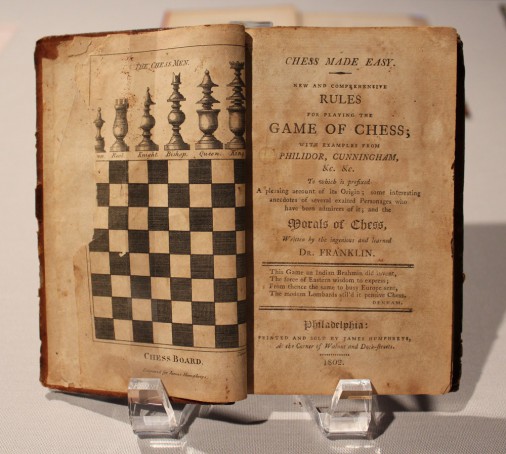
Chess Made Easy, New and Comprehensive Rules for Playing the Game of Chess featuring Morals of Chess by Benjamin Franklin, 1802
Collection of the World Chess Hall of Fame
Nearly every Hall of Fame member authored or contributed to books on strategy, notable games, and their personal experiences. Chess students eagerly purchased books by their favorite players to better understand and master the game.

Mitchell's Guide to the Game of Chess: A Complete Course of Instruction for Beginners by David. A. Mitchell, c 1920
Collection of the World Chess Hall of Fame
This book was Jack Collins first chess book. The inscription reads, "To Jack from Dad, December 25, 1930."

Teaching the Theory of Modern Chess Openings by A.C. СУЗТИН, 1958
Collection of John McCrary
This book was owned by Bobby Fischer and inscribed, "Bobby Fischer, May 1959, $1.00, Earth. U.S.A."

Marshall’s Chess “Swindles” by Frank James Marshall, 1914
Collection of the World Chess Hall of Fame
Inscription by Frank Marshall reads, “Milwaukee, Wis. June 26, 1915. To Oscar W. Ristan for his fine game this evening against the author, Frank J. Marshall.”
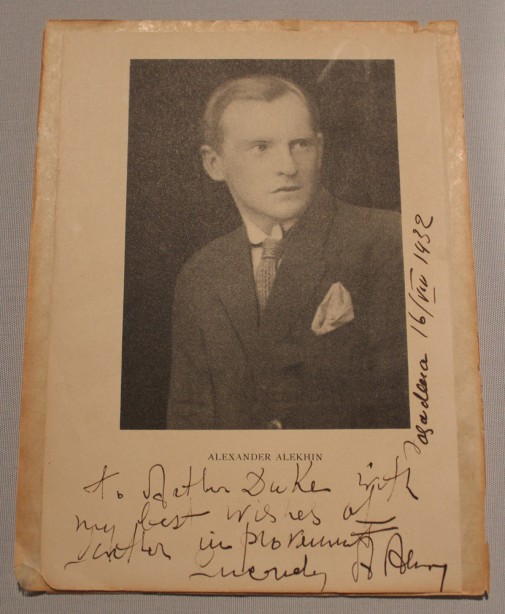
Letter/photo signed by Alexander Alekhine, dated 1932

Letter written by José Raúl Capablanca, dated April 23, 1929
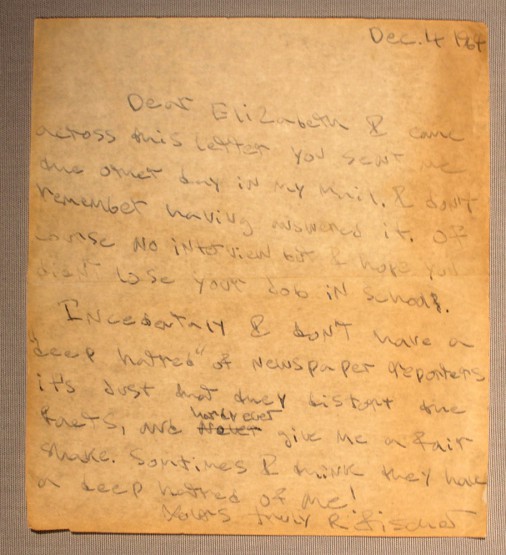
Letter written by Bobby Fischer, dated December 4, 1964
Many chess masters maintained an intimidating public face, but their personal correspondence expresses normal human emotions and vulnerabilities. Their words of uncertainty, frustration, and joy reveal a side rarely shown to fans and casual acquaintances.

Chess Set owned by Judge John F. Long, after 1840
Collection of the Missouri History Museum
This chess set once belonged to Judge John F. Long (1818-1888) and was used to play with his close friend Ulysses S. Grant, for whom Long served as the Saint Louis agent during Grant’s presidency. A descendent of Revolutionary War veteran and early resident of Saint Louis, Captain John Long, Judge Long was born in Saint Louis County and served in a number of official capacities including police chief of the City of Saint Louis, Saint Louis County Marshal, County Judge, and Collector of Customs of the port of St. Louis.
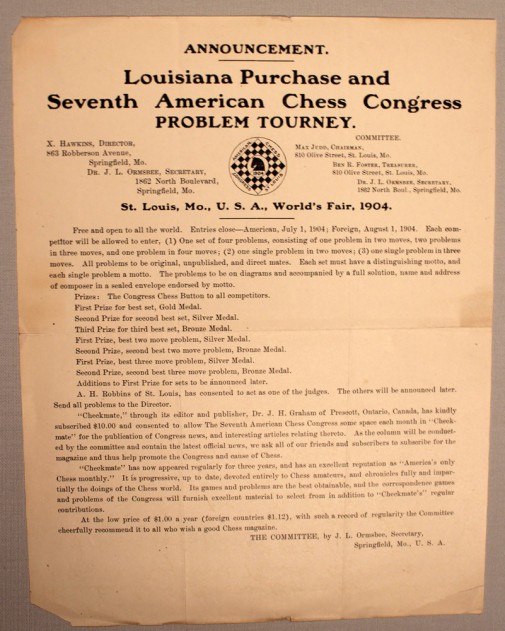
Announcement for the Seventh American Chess Congress in Saint Louis, 1904
Collection of Jeanne and Rex Sinquefield

Pin from the Seventh American Chess Congress in Saint Louis, 1904
Collection of the Missouri History Museum

Photograph of Frank J. Marshall, signed 1929
Collection of the World Chess Hall of Fame
The 1904 World’s Fair drew national and international visitors to Saint Louis. It also served as an occasion to hold the Seventh Annual Chess Congress in the city. Tournament organizer Max Judd attempted to have the winner of this tournament named U.S. Champion, having openly disputed Harry Nelson Pillsbury’s claim to the title. Frank J. Marshall, widely regarded as the preeminent chess player of early 20th century and founder of the Marshall Chess Club in New York City, was named tournament champion.
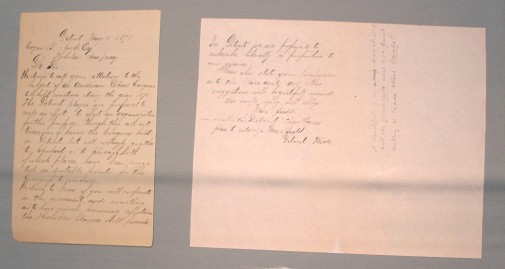
Manuscript letter written by Max Judd, dated 1871
Collection of the John G. White Chess and Checkers Collection, Cleveland Public Library
Max Judd (1851-1906) was the founder and president of the St. Louis Chess Club and is widely regarded as Saint Louis’ premiere chess talent of the nineteenth century. Judd played in six American Chess Congress tournaments, including the Seventh in Saint Louis in 1904, for which he acted as chair and ultimately placed second after being edged out by champion Frank Marshall. Judd defeated many of the greatest players of the day, including then-U.S. Champion Jackson Showalter in 1890, though he did not claim the title afterward. Born in Cracow, Poland, Judd also had a brief career as a diplomat, appointed by President Grover Cleveland as the U.S. Consul General to Austria.

Fidelity Chess Challenger Computer, first manufactured 1977
Collection of the World Chess Hall of Fame
The Fidelity Chess Challenger was the first commercial chess computer of its kind when it was introduced in 1977. Inspired by a scene from the television show Star Trek in which Spock is playing chess against the Enterprise computer, the Chess Challenger 1 was invented by Fidelity Electronics founder Sidney Samole and programmer Ron C. Nelson. In the years to follow, Fidelity chess computers would dominate the competitive computer chess world, winning the first four U.S. Computer Championships and the first four World Microcomputer Chess Championships.

BORIS Electronic Chess Computer, © 1977/1978
Collection of the World Chess Hall of Fame
Developed by Chafitz Inc. and Applied Concepts, Inc., BORIS was among the earliest portable chess computers available to the general public. Released in 1978, BORIS was advertised as a “talking” chess computer because it flashed not only its moves across the small LED panel, but also a limited number of random messages from the standard “NICE MOVE” and “I EXPECTED THAT” to more provocative statements like “MAY I CHEAT?” and “SPOT ME A QUEEN.” In addition to its handsome walnut case, another feature of BORIS was its programmability, as players were able to play either white or black, to set up the board in any position desired, and to switch sides with the computer at any time.
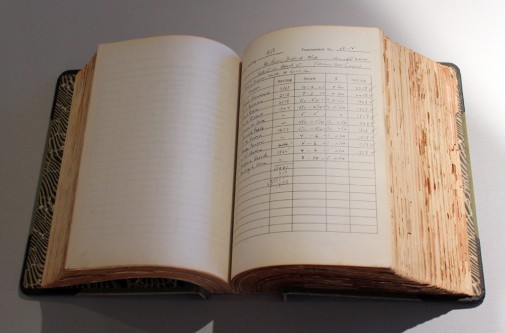
Kenneth Harkness' Notebook, date unknown
Collection of the World Chess Hall of Fame
This remarkable and unique relic is the notebook that arbiter Kenneth Harkness used to devise his chess rating system, which was used by the U.S. Chess Federation from 1950 to 1960. It contains the scores of tournaments, some famous events long since history even in Harkness’ day, that he rated by hand to test his formula. Around 1960, the Harkness system was modified in accordance with the statistical theory of Arpad Elo, whose name has stuck to the current international (FIDE) rating system. For his extremely important contributions to the game of chess, Harkness was inducted into the U.S. Hall of Fame in 1997.

Marcel Duchamp
The Imagery of Chess invitation/brochure, 1944
Collection of the World Chess Hall of Fame
In 1944, New York art dealer Julien Levy invited thirty-two artists, many of them members of the Surrealist group, to exhibit chess-inspired artwork in a show he called “The Imagery of Chess.” Featuring the silhouettes of two of the more striking pieces from Max Ernst’s Wood Chess Set on the front, the back of the brochure lists the courageous individuals (Ernst, artist Dorothea Tanning, Julien Levy, designer and photographer Xanti Schawinsky, former director of the Museum of Modern Art Alfred H. Barr, Jr., and architect Frederick Kiesler; the composer Vittorio Rieti was not listed) who agreed to play a blindfold match against the “World Champion of Blindfold Chess” George Koltanowski who had broken the record for the most simultaneous blindfold matches in 1937 with thirty-four. All were defeated except Kiesler, who managed a draw.

The American Red Cross Chess, Checkers, and TIC-TAC-TOE Pocket Set from The American Red Cross New York Chapter, c 1940-1944
Collection of the World Chess Hall of Fame

The American Red Cross Chess, Checkers, and TIC-TAC-TOE Pocket Set from The American Red Cross New York Chapter, c 1940-1944
Collection of the World Chess Hall of Fame
During World War II, the American Red Cross distributed these portable board games to enlisted soldiers. Leisure activities combatted boredom and helped soldiers pass the time during long periods of inaction between battles.
This pocket set was used by Staff Sgt. Arthur D. Williams when he was held captive in Stalag Luft IV after being shot down on October 5, 1944.
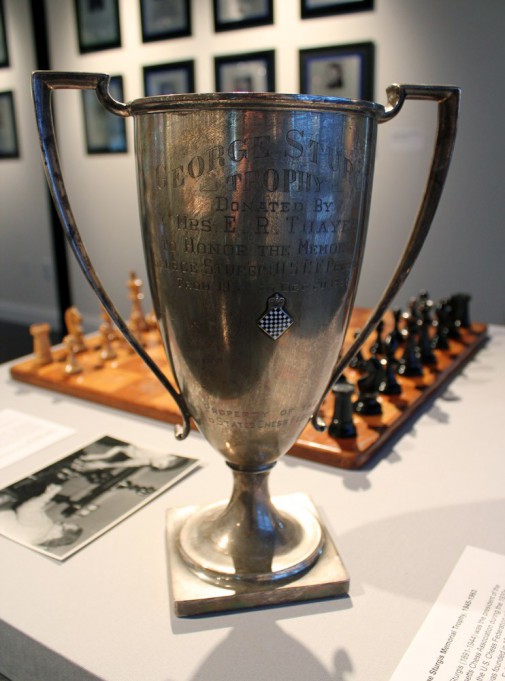
George Sturgis Memorial Trophy, 1945-1963
Collection of the World Chess Hall of Fame
George Sturgis (1891-1944) was the president of the Massachusetts Chess Association during the 1930s and first president of the U.S. Chess Federation when the organization was founded in 1939. The George Sturgis trophy, donated by Mrs. E. R. Thayer, was presented to Anthony Santasiere in 1945 after he won the U.S. Open in Peoria, Illinois and has since had inscribed on it the names of numerous other U.S. Open Champions, including Bobby Fischer.

Chess board and clock from the home of Jack Collins, dates unknown
Collection of the World Chess Hall of Fame

Photograph of a young Bobby Fischer and Jack Collins playing chess in his home, dates unknown
Collection of the World Chess Hall of Fame
This clock and board belonged to Jack Collins, considered the greatest teacher in the history of American chess. The country’s best young talent honed their chess skills under Collins’ watchful eye. This chess set and clock are seen in a photograph in which Collins is being challenged by his best-known and most talented student, a young Bobby Fischer.
It is a well-known fact that Collins altered this clock to ring every ten seconds to increase the speed of Fischer’s moves.

World Chess Championship Match ticket, 1972
Collection of the World Chess Hall of Fame
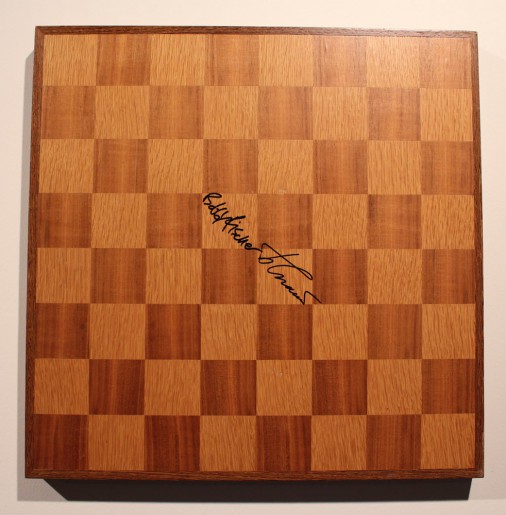
World Chess Championship chessboard signed by Bobby Fischer and Boris Spassky, 1972
Collection of Dr. Jeanne and Rex Sinquefield
Ticketholders to the 1972 World Chess Championship watched Bobby Fischer defeat Boris Spassky of the Soviet Union in what is arguably the most famous chess match in the history of the game. They also witnessed a media circus unfold, as the Cold War rivalry and Fischer’s erratic behavior attracted worldwide attention. Chess exploded in popularity in the United States as a result of the World Chess Championship, and Fischer became an instant American icon.
This board, signed by both Fischer and Spassky, was used in the third match of the championship, dubbed the “back room game” because Fischer blamed his loss in the first match (and subsequent default in the second match) on cameras in the room that he claimed distracted him. In what is widely considered to be the turning point in the match, Spassky agreed to play the third game in a small room away from the cameras’ glare and out of view from spectators. Fischer would go on to win that game and the Championship 12½ - 8½.

Susan Polgar with Paul Truong
Breaking Through: How the Polgar Sisters Changed the Game of Chess, 2005
Collection of the World Chess Hall of Fame

Jennifer Shahade
Play Like a Girl! Tactics by 9Queens, 2011
Collection of the World Chess Hall of Fame
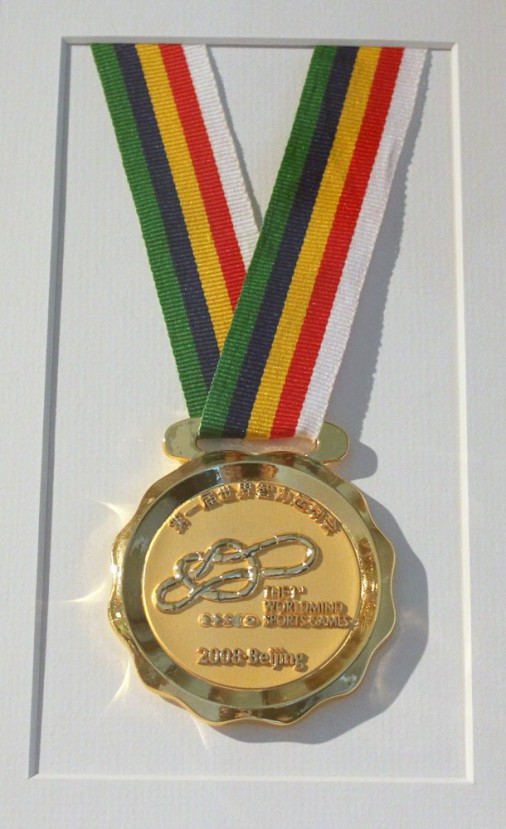
Gold Medal won by Alexandra Kosteniuk at the 2008 Mind Sports Games in Beijing, China, 2008
Collection of the World Chess Hall of Fame

Frank J. Marshall Award presented to Yasser Seirawan, August 2003
Collection of the World Chess Hall of Fame
To celebrate “Kings vs. Queens: A Battle of the Sexes” at the Chess Club and Scholastic Center from September 9-16, 2011, the World Chess Hall of Fame has selected objects to display from the permanent collection donated by planned participants Judit Polgar and Alexandra Kosteniuk and commentators Yasser Seriawan and Jennifer Shahade. Note: Judit Polgar was unable to participate in the Kings vs. Queens tournament.

Poster for the XXV Torneo Magistral Y Latinoamericano, Argentina, 1962
Collection of the World Chess Hall of Fame
Donated to the Hall of Fame by the Byrne Family, this beautiful lithographic poster for the XXV Torneo Magistral y Latinoamericano, held in Argentina in 1962, was a valued memento of U.S. Hall of Fame member Donald Byrne. In addition to his own signature on square h2, it features the signatures of numerous prominent players who participated in the tournament, including Carl Pilnick (a8), Miguel Najdorf (a2), Lev Polugaevsky (b6), Carlos Bielicki (e8), Oscar Panno (f8), Bruno Parma (f7), Luděk Pachman (f3), Raúl Sanguineti (f3), World Chess Hall of Fame member Vasily Smyslov (f1), René Letelier (g7), Héctor Rossetto (g6), Jonathan Penrose (h8), Carlos Guimard (h5), László Szabó (h3), and Erich Eliskases (h1).

Paul Morphy Silver Set, 1857
Collection of the World Chess Hall of Fame
Paul Morphy (1837-1884), a lifelong resident of New Orleans, is called the “pride and sorrow of chess.” He was arguably the best player in the world and could have been recognized as the first true World Champion, but he retired at the peak of his talent after an active career lasting only two years.
Morphy burst into national prominence by winning the First American Chess Congress in 1857, making him the second U.S. champion in history. He then traveled to Europe where he easily defeated the best players. Morphy’s style of play was as spectacular as his results. Often he won by brilliant sacrifices that still amaze and entertain players today.
When Paul Morphy returned to the U.S., he was acclaimed as a national hero. Even among the millions of Americans who did not play chess, he was viewed as having brought worldwide honor to the nation. Inexplicably, Morphy retired from competitive play in 1859, and he remains one of the most brilliant and mysterious figures in the history of chess.
This coin silver beverage set was presented to Paul Morphy for winning the first American Chess Congress in 1857. Morphy’s good friend Judge Bermudez inherited the set. It subsequently passed through several hands before it came to be owned by a French family in Louisiana, who sold them to the U.S. Chess Trust in 1986. The matching salver—engraved with a picture of Morphy playing Louis Paulsen—remains in a private collection. A lawyer by trade and a well-educated gentleman in his own eyes, Morphy viewed chess as an amateur rather than a professional pursuit, and in accordance with this belief would not accept a cash prize for his victory. Consequently, the tournament organizers presented Morphy with this silver set costing $300, the exact amount of the tournament’s first-place cash prize.


The World Chess Hall of Fame is proud to honor Sidney Samole and his accomplishments to the chess world.








































